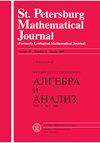关于热量损失的问题:群体本能与个人感受
IF 0.6
4区 数学
Q2 MATHEMATICS
引用次数: 5
摘要
讨论了与有限个球互补的R3\mathbb{R}^3域中热的稳态分布的几个问题。对这些问题的研究是由M.L.Glasser于1977年发起的。然后,在1978年,M.L.Glasser和S.G.Davison提出了数值证据,证明当球彼此靠近时,R3中两个相等球的热通量会减少。这些作者从睡眠中的armadillos的行为习惯来解释这一结果,动物之间距离越近,它们失去的热量就越少。很久以后,在2003年,A.Eremenko严格地证明了这种单调性,并提出了关于热通量的新问题。本文的目的是调查这一领域的最新发展,回答一些悬而未决的问题,并提请注意关于由R3\mathbb{R}^3中的n≥2n\ge2个球组成的配置的热通量的几个具有挑战性的悬而未决的问题。本文章由计算机程序翻译,如有差异,请以英文原文为准。
Problems on the loss of heat: herd instinct versus individual feelings
Several problems are discussed concerning steady-state distribution of heat in domains in
R
3
\mathbb {R}^3
that are complementary to a finite number of balls. The study of these problems was initiated by M. L. Glasser in 1977. Then, in 1978, M. L. Glasser and S. G. Davison presented numerical evidence that the heat flux from two equal balls in
R
3
\mathbb {R}^3
decreases when the balls move closer to each other. Those authors interpreted this result in terms of the behavioral habits of sleeping armadillos, the closer animals to each other, the less heat they lose. Much later, in 2003, A. Eremenko proved this monotonicity property rigorously and suggested new questions on the heat fluxes.
The goal of this paper is to survey recent developments in this area, provide answers to some open questions, and draw attention to several challenging open problems concerning heat fluxes from configurations consisting of
n
≥
2
n\ge 2
balls in
R
3
\mathbb {R}^3
.
求助全文
通过发布文献求助,成功后即可免费获取论文全文。
去求助
来源期刊

St Petersburg Mathematical Journal
MATHEMATICS-
CiteScore
1.00
自引率
12.50%
发文量
52
审稿时长
>12 weeks
期刊介绍:
This journal is a cover-to-cover translation into English of Algebra i Analiz, published six times a year by the mathematics section of the Russian Academy of Sciences.
 求助内容:
求助内容: 应助结果提醒方式:
应助结果提醒方式:


